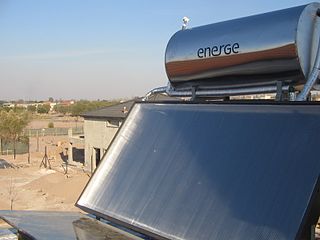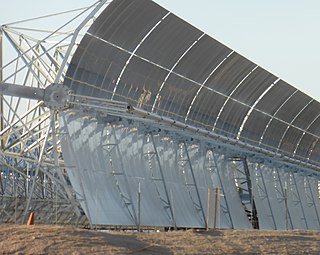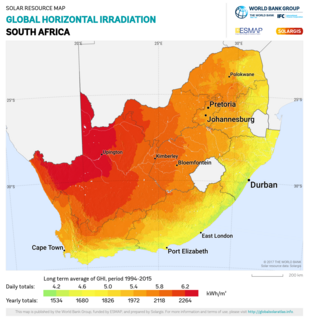
Solar thermal energy (STE) is a form of energy and a technology for harnessing solar energy to generate thermal energy for use in industry, and in the residential and commercial sectors.

A parabolic trough is a type of solar thermal collector that is straight in one dimension and curved as a parabola in the other two, lined with a polished metal mirror. The sunlight which enters the mirror parallel to its plane of symmetry is focused along the focal line, where objects are positioned that are intended to be heated. In a solar cooker, for example, food is placed at the focal line of a trough, which is cooked when the trough is aimed so the Sun is in its plane of symmetry.

The Andasol solar power station is a 150-megawatt (MW) concentrated solar power station and Europe's first commercial plant to use parabolic troughs. It is located near Guadix in Andalusia, Spain, and its name is a portmanteau of Andalusia and Sol. The Andasol plant uses tanks of molten salt as thermal energy storage to continue generating electricity, irrespective of whether the sun is shining or not.

Concentrated solar power systems generate solar power by using mirrors or lenses to concentrate a large area of sunlight onto a receiver. Electricity is generated when the concentrated light is converted to heat, which drives a heat engine connected to an electrical power generator or powers a thermochemical reaction.

A solar power tower, also known as 'central tower' power plant or 'heliostat' power plant, is a type of solar furnace using a tower to receive focused sunlight. It uses an array of flat, movable mirrors to focus the sun's rays upon a collector tower. Concentrating Solar Power (CSP) systems are seen as one viable solution for renewable, pollution-free energy.
SolarReserve was a developer of utility-scale solar power projects which include Concentrated Solar Power (CSP) and Photovoltaic (PV) technology. The company has commercialized solar thermal energy storage technology that enables solar power tower CSP plants to deliver electricity day and night. In this technology, a molten salt is used to capture the energy from the sun and store it. When electricity is needed, the stored liquid salt is used to turn water into steam to turn a turbine and generate electricity.

Torresol Energy is a company dedicated to developing renewable energy and alternative energies, focusing on concentrated solar energy. It is based in the city of Getxo in Biscay Province (Vizcaya), in the Basque Country of northern Spain.

eSolar is a privately held company that develops concentrating solar power (CSP) plant technology. The company was founded by the Pasadena-based business incubator Idealab in 2007 as a developer of CSP plant technology. The company aims to develop a low cost alternative to fossil fuels through a combination of small heliostats, modular architecture, and a high-precision sun-tracking system. In October 2017, an article in GreenTech Media suggested that eSolar ceased business in late 2016.
South Africa has a large energy sector, being the third-largest economy in Africa. The country consumed 227 TWh of electricity in 2018. The vast majority of South Africa's electricity was produced from coal, with the fuel responsible for 88% of production in 2017. South Africa is the 7th largest coal producer in the world. As of July 2018, South Africa had a coal power generation capacity of 39 gigawatts (GW). South Africa is the world's 14th largest emitter of greenhouse gases. South Africa is planning to shift away from coal in the electricity sector and the country produces the most solar and wind energy by terawatt-hours in Africa. The country aims to decommission 34 GW of coal-fired power capacity by 2050. It also aims to build at least 20 GW of renewable power generation capacity by 2030. South Africa aims to generate 77,834 megawatts (MW) of electricity by 2030, with new capacity coming significantly from renewable sources to meet emission reduction targets. Through its goals stated in the Integrated Resource Plan, it announced the Renewable Energy Independent Power Producer Procurement Programme, which aims to increase renewable power generation through private sector investment.

Solar power in South Africa includes photovoltaics (PV) as well as concentrated solar power (CSP). In 2016, South Africa had 1,329 MW of installed solar power capacity. Installed capacity is expected to reach 8,400 MW by 2030.

Cerro Dominador Solar Power Plant is a 210-megawatt (MW) combined concentrated solar power and photovoltaic plant located in the commune of María Elena in the Antofagasta Region of Chile, about 24 kilometres (15 mi) west-northwest of Sierra Gorda. The project was approved by the Chilean government in 2013 and construction was started by Abengoa Solar Chile, a branch of the multinational Abengoa Spain. The plant was inaugurated on June 8, 2021. A follow up project called Likana Solar bid $33.99/MWh in an auction in August 2021.

Bokpoort CSP is a concentrated solar power (CSP) thermal energy power plant, located near Groblershoop in the Northern Cape province of South Africa. The project was procured pursuant to the Renewable Energy Independent Power Producer Procurement (REIPPP) program initiated by the South African Department of Energy.
Redstone Solar Thermal Power (RSTP) is a solar power tower with molten salt energy storage, located in Postmasburg, near Kimberley, in the Northern Cape Region of South Africa. Redstone will have a capacity of 100 megawatts (MW) to deliver power to 200,000 people and was awarded in bid window 3.5 of the REIPPP at a strike price of 122.3 ZAR/KWh including time of day pricing in 2015. The project was initially based on the technology of now bankrupt Solar Reserve, but was delayed for several years because the PPA was not signed by Eskom until 2018. After the project was revived the plant is now under construction and the technology will be provided by Brightsource and John Cockerill, as demonstrated in the Noor Energy 1 project in the UAE.
The Xina Solar One Power Station is a 100 MW (130,000 hp) concentrated solar power plant in South Africa. Constructed between 2014 and 2016, the power station was commercially commissioned in 2017. The solar component of this power station is complemented by molten salt thermal storage technology, which allows the power station to provide full power for another 5.5 hours, after the sun goes down, thus supplying energy during South African peak hours. The consortium that owns the solar farm comprises a foreign independent power producer (IPP), two domestic finance development companies and a local charity. The energy generated here is sold directly to Eskom, the South African national electricity utility company, under a 20-year power purchase agreement (PPA).
The Dyason's Klip 1 Power Station,, is an 86 megawatts solar power plant in South Africa. The power station was developed and is owned and operated by a consortium comprising an international independent power producer (IPP), South African and European investors and a local charitable trust. Commercially commissioned in February 2020, the solar farm's 217 GWh of energy production annually is sold to Eskom, the national electricity utility company, under a long-term power purchase agreement (PPA).
The Prieska–Total Solar Power Station, also Mulilo Prieska Solar Power Station, is an 86 megawatts solar power plant in South Africa. The solar farm was developed and is owned by a consortium comprising five independent power producers (IPPs), development finance companies and private investment firms. The power station owners formed a special purpose vehicle (SPV) company called Mulilo Prieska PV (RF), to design, finance, construct, own, operate and maintain the power station and related infrastructure. The off-taker of the energy generated here is Eskom Holdings, the public electricity utility parastatal of South Africa. A 20-year power purchase agreement between Murillo Prieska PV and Eskom, governs the sale and purchase of electricity between the power station and the electric utility.
The De Wildt Solar Power Station, is a 50 MW solar power station in South Africa. The power station was developed as is owned by a consortium of five South African independent power producers (IPPs) and investment firms. The energy generated here is sold directly to Eskom, the national electricity utility parastatal company, for integration into the South African grid. A 20-year power purchase agreement (PPA) between the solar farm owners and Eskom governs the sale and purchase of electricity between the two.
The Sirius 1 Solar Power Station, is an 86 MW solar power station in South Africa. The power station was developed by a joint venture between Aurora Power Solutions and Sirius Solar PV Project One. The off-taker of the energy generated here is Eskom Holdings, the South African national electricity utility parastatal company. A 20-year power purchase agreement between Eskom and the owners of the power station, governs the purchase and sale of electricity between the two. Commercial commissioning was achieved in February 2020.










